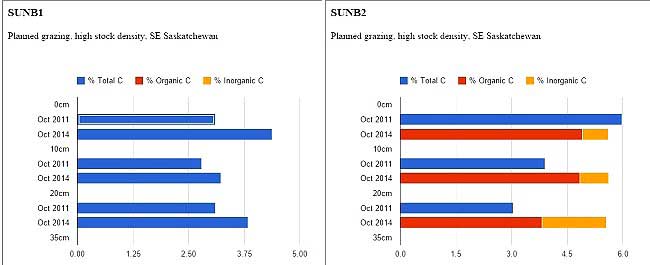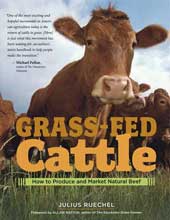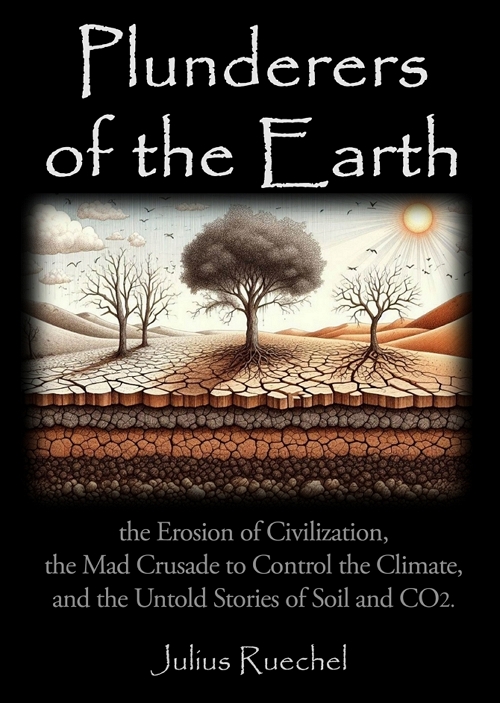Soil Carbon Cowboys
In the Soil Carbon Cowboys video, featured below, filmmaker Peter Byck follows three cattle ranchers - Allen Williams from Mississippi, USA, Gabe Brown from North Dakota, USA, and Neil Dennis from Saskatchewan, Canada - whose innovative grazing strategies are redefining how cattle can be used to profitably improve the land.
The video discuss some of the most important benefits of rotational grazing - building organic matter through rotational grazing (carbon sequestration), increased erosion resistance, improved soil moisture retention, dramatic lowering of disease in the cattle herd, reduced fertilizer and pesticide needs, reduced labor and equipment costs, and all this accompanied by a dramatic increase in land productivity.
The video is also full of practical hands-on ideas, such as how to combine permanent and portable electric fences, what stocking densities work well during rotational grazing, and innovative ways to drive over single wire electric fences with your ATV without needing to build gates everywhere.
There's a lot packed into a short 12 minutes...
I hope you enjoy the video as much as I did!
Want to learn a little more about the three ranchers featured in the video?
More About Neil Dennis
Many thanks to Neil Dennis for contacting me through my website to notify me of this excellent video and for taking the time to answer my questions about his operation during our subsequent phone call.
A little more about Neil's ranch:
Neil's ranch - Sunnybrae Farms in Saskatchewan - is strictly focused on custom grazing for the commercial cattle industry. He uses pasture-based cattle farming (holistic management) strictly to reduce his costs, improve his soil, and increase the productivity of his land!
In his pasture rotation he typically lets the land rest for around 80 days between grazing passes and uses a stocking density of around 800 to 1000 head of cattle per acre! His cattle generally continue to graze through the winter months.
He rarely builds gates anymore in his fences thanks to the innovative setup he's attached to his ATV, which allows him to drive over the wires (seen several times throughout the Soil Carbon Cowboys video, starting at the 03:08 minute mark). He uses water alleys rather than mobile cattle water troughs to provide water access for his cattle during his pasture rotation.
One of the things he emphasized during our telephone conversation was that setting up a pasture rotation is just the very beginning. After that the soil just keeps changing, and changing, and changing - for the better - as organic matter builds up in the soil. This has translated into a big increase in his pasture productivity (his land has improved so much since he switched to pasture-based rotational grazing that his stocking rates are roughly double those of his neighbor who is still managing his cattle in the 'traditional' way).
He also emphasized how much his soil moisture absorption has improved since he began. Soil percolation tests on his farm showed less than 1" of water absorbed per hour before he switched to rotational grazing. Now it is more then 8" of water absorbed per hour. (The test is performed by pounding a pipe into the soil, pouring water in, and then timing the rate of water absorption). That represents a huge increase in ground water to support plant growth because the water is not lost to runoff or evaporation. And that makes his pastures significantly more erosion-proof!
Neil has also been working with the Soil Carbon Coalition, which is a non-profit organization that does systematic organic matter testing on ranches to monitor how various farming techniques affect organic matter content in the soil, with the goal of promoting farming techniques that build organic matter. If you use the "Find" function to search for "Neil Dennis" on their homepage, you can read more about the testing done on his farm.
The Soil Carbon Coalition has tested two sites on Neil's farm - SUNB1 and SUNB2. Both show a remarkable increase in soil carbon in just 3 years (2011 - 2014) in all three measured depths (0-10 cm, 10-20cm and 10-35 cm). It's particularly noteworthy that the organic matter increase was so striking particularly in the deeper soil horizons, not just at the surface!
You can see how much his soil results improved between 2011 and 2014 in the two charts below (courtesy of the Soil Carbon Coalition):

And finally, he also reiterated just how much more time he has on his hands nowadays since switching to rotational grazing. Pretty impressive, considering that his 800-1000 head ranch is a one-man operation!
Holistic Management International has posted an excellent case study of Neil's farm on their website: Case Studies: Sunnybrae Farms.
And he has also been featured on the Practical Farmers of Iowa website: Trip to Sunnybrae Farm - Mob Grazing.
Neil has a website coming soon in which he wants to share more of his farming techniques (I'll let you know as soon as it goes live).
More About Allen Williams
Allen Williams is the President of Livestock Management Consultants LLC. You can learn more about Allen Williams in this highly recommended Youtube interview featuring Allen along with Peter Byck, the producer of the Soil Carbon Cowboys video on Vimeo. In the video interview Allen shares both his top-down industry-wide perspective of how the grass-fed beef industry is evolving as well as many of his own personal experiences from his own cattle ranch.
More About Gabe Brown
You can learn more about Gabe Brown's ranch, which he also manages using holistic management practices, here on his farm's website.
Would you like to see your cattle ranch featured on this website?
Do you have a story to share about your pasture-based cattle farming experiences? I'd love to hear how you manage your cattle ranch! Use the form on my contact page to get in touch.



